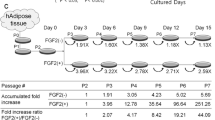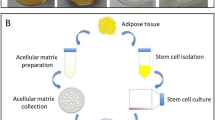Abstract
The adipogenesis effect of fibroblast growth factor 10 (FGF10) has been demonstrated in many studies. The aim of this study is to render a novel method which can continuously induce hypodermal adipose-derived stem cell (ADSC) differentiation and maturation in vivo and in vitro using FGF10. We constructed a recombinant pcDNA3.0-FGF10-MSC which can continuously express FGF10 by transfected FGF10 into a human mesenchymal stem cell (MSC) clone, and we cultured ADSCs from human subcutaneous resected adipose tissue. An in vitro and in vivo co-culture system of pcDNA3.0-FGF10-MSC and ADSCs was then established. We observed the characteristics of ADSCs, monitored the adipogenesis-related transcription factor CAAT/enhancer binding protein-β, peroxisome proliferator-activated receptor-γ, and measured the adipose tissue layer of carrier animals. The results showed that FGF10 secreted from pcDNA3.0-FGF10-MSC could induce ADSC differentiation into mature adipocytes consistently. The study demonstrated that FGF10 can promote the adipogenesis effect in situ, and the autotransplantation of a carrier continuously secreting FGF10 may be utilized for increasing local subcutaneous adipose tissue in cosmetology.







Similar content being viewed by others
References
Asaki T.; Konishi M.; Miyake A.; Kato S.; Tomizawa M.; Itoh N. Roles of fibroblast growth factor 10(FGF10) in adipogenesis in vivo. Mol Cell Endocrinol 218(1–2): 119–128; 2004.
Bhushan A.; Itoh N.; Kato S.; Thiery J. P.; Czernichow P.; Bellusci S.; Scharfmann R. FGF10 is essential for maintaining the proliferative capacity of epithelial progenitor cells during early pancreatic organogenesis. Development 128(24): 5109–5117; 2001.
Constance C. M.; Morgan 4th J. I.; Umek R. M. C/EBP alpha regulation of the growth-arrest-associated gene gadd45. Mol Cell Biol 16(7): 3878–3883; 1996.
Desvergene B.; Wahli W. Peroxisome proliferator-activated recepor: nuclear control of metabolism. Endocr Rev 20(5): 649–688; 1999.
Durcova-Hills G.; Adams I. R.; Barton S. C.; Surani M. A.; McLaren A. The role of exogenous fibroblast growth factor-2 on the reprogramming of primordial germ cells into pluripotent stem cells. Stem Cells 24(6): 1441–1449; 2006.
Erickson G. R.; Gimble J. M.; Franklin D. M.; Rice H. E.; Awad H.; Guilak F. Chondrogenic potential of adipose tissue-derived stromal cells in vitro and in vivo. Biochem Biophys Res Commun 18(2): 763–769; 2002.
Guan Y.; Breyer M. D. Targeting peroxisome proliferator-activated receptors(PPARs) in kidney and urologic disease. Minerva Urol Nefrol 54(2): 65–79; 2002.
Gregoire F. M. Adipocyte differentiation: from fibroblast to endocrine cell. Exp Biol Med 226(11): 997–1002; 2001.
Itoh N. FGFs as multifunctional signaling molecules: diversity of structure and function. Seikagaku 73(7): 525–535; 2001.
Iverson R. E.; Pao V. S. MOC-PS(SM) CME article: liposuction. Plast Reconstr Surg 121(4 Suppl): 1–11; 2008.
Jiang Y.; Jahagirdar B. N.; Reinhardt R. L.; Schwartz R. E.; Keene C. D.; Ortiz-Gonzalez X. R.; Reyes M.; Lenvik T.; Lund T.; Blackstad M.; Du J.; Aldrich S.; Lisberg A.; Low W. C.; Largaespada D. A.; Verfaillie C. M. Pluripotency of mesenchymal stem cells derived from adult marrow. Nature 418(6893): 41–49; 2002.
Joannides A.; Gaughwin P.; Scott M.; Watt S.; Compston A.; Chandran S. Postnatal astrocytes promote neural induction from adult human bone marrow-derived stem cells. J Hematother Stem Cell Res 12(6): 681–688; 2003.
Kawaguchi N.; Toriyama K.; Nicodemou-Lena E.; Inou K.; Torii S.; Kitagawa Y. De novo adipogenesis in mice at the site of injection of basement membrane and basic fibroblast growth factor. Proc Natl Acad Sci USA 95(3): 1062–1066; 1998.
Koh E. H.; Kim M. S.; Park J. Y.; Kim H. S.; Youn J. Y.; Park H. S.; Youn J. H.; Lee K. U. Peroxisome proliferator-activated receptor (PPAR)-alpha activation prevents diabetes in OLETF rats: comparison with PPAR-gamma activation. Diabetes 52(9): 2331–2337; 2003.
Konishi M.; Asaki T.; Koike N.; Miwa H.; Miyake A.; Itoh N. Role of FGF10 in cell proliferation in white adipose tissue. Mol Cell Endocrinol 249(1–2): 71–77; 2006.
Matsusue K.; Peters J. M.; Gonzalez F. J. PPARβ/δ potentiates PPARγ-stimulates adipocyte differentiation. FASEB J 18(12): 1477–1479; 2004.
Nakagami H.; Morishita R.; Maeda K.; Kikuchi Y.; Ogihara T.; Kaneda Y. Adipose tissue-derived stromal cells as a novel option for regenerative cell therapy. J Atheroscler Thromb 13(2): 77–81; 2006.
Pittenger M. F.; Mosca J. D.; McIntosh K. R. Human mesenchymal stem cells: progenitor cells for cartilage, bone, fat and stroma. Curr Top Microbiol Immunol 251: 3–11; 2000.
Rangappa S.; Fen C.; Lee E. H.; Bongso A.; Sim E. K. Transformation of adult mesenchymal stem cells isolated from the fatty tissue into cardiomyocytes. Ann Thorac Surg 75(3): 775–779; 2003.
Reilly J. F.; Maher P. A. Importin β-mediated nuclear import of fibroblast growth factor receptor: role in cell proliferation. J Cell Biol 152(6): 1307–1312; 2001.
Rider D. A.; Dombrowski C.; Sawyer A. A.; Ng G. H.; Leong D.; Hutmacher D. W.; Nurcombe V.; Cool S. M. Autocrine fibroblast growth factor 2 increases the multipotentiality of human adipose-derived mesenchymal stem cells. Stem Cells 26(6): 1598–1608; 2008.
Rim J. S.; Mynatt R. L.; Gawronska-Kozak B. Mesenchymal stem cells from the outer ear: a novel adult stem cell model system for the study of adipogenesis. FASEB J 19(9): 1205–1207; 2005.
Rosen E. D.; Walkey C. J.; Puigserver P.; Spiegelman B. M. Transcriptional regulation of adipogenesis. Genes Dev 14(11): 1293–1307; 2000.
Safford K. M.; Hicok K. C.; Safford S. D.; Halvorsen Y. D.; Wilkison W. O.; Gimble J. M.; Rice H. E. Neurogenic differentiation of murine and human adipose-derived stromal cells. Biochem Biophys Res Commun 294(2): 371–379; 2000.
Sakaue H.; Konishi M.; Ogawa W.; Asaki T.; Mori T.; Yamasaki M.; Takata M.; Ueno H.; Kato S.; Kasuga M.; Itoh N. Requirement of fibroblast growth factor 10 in development of white adipose tissue. Genes Dev 16(8): 908–912; 2002.
Shea C. M.; Edgar C. M.; Einhorn T. A.; Gerstenfeld L. C. BMP treatment of C3H10T1/2 mesenchymal stem cells induces both chondrogenesis and osteogenesis. J Cell Biochem 90(6): 1112–1127; 2003.
Steck E.; Bertram H.; Abel R.; Chen B.; Winter A.; Richter W. Induction of intervertebral disc-like cells from adult mesenchymal stem cells. Stem Cells 23(3): 403–411; 2005.
Tao H.; Yoshimoto Y.; Yoshioka H.; Nohno T.; Noji S.; Ohuchi H. FGF10 is mesenchymally derived stimulator for epidermal development in the chick embryonic skin. Mech Dev 116(1–2): 39–49; 2002.
Williams S. C.; Baer M.; Dillner A. J.; Johnson P. F. CRP2(C/EBPβ) contains a DNA binding and cell specificity bipartite regulatory domain that controls transcriptional activation. EMBO J 5(4): 241–258; 1995.
Wu M. J.; Yang L.; Liu H. Q. Differentiation potential of human embryonic mesenchymal stem cells for skin-related tissue. Br J Dermatol 155(2): 282–291; 2006.
Yamaoka T.; Yoshino K.; Yamada T.; Yano M.; Matsui T.; Yamaguchi T.; Moritani M.; Hata J.; Noji S.; Itakura M. Transgenic expression of FGF8 and FGF10 induces transdifferentiation of pancreatic islet cells into hepatocytes and exocrine cells. Biochem Biophys Res Commun 292(1): 138–143; 2002.
Yamasaki M.; Emoto H.; Konishi M.; Mikami T.; Ohuchi H.; Nakao K.; Itoh N. FGF-10 is a growth factor for preadipocytes in white adipose tissue. Biochem Biophys Res Commun 258(1): 109–112; 1999.
Yao C. C.; Yao P.; Wu H.; Zha Z. G. Absorbable collagen sponge combined with recombinant human basic fibroblast growth factor promotes nerve regeneration in rat sciatic nerve. J Mater Sci Mater Med 18(10): 1969–1972; 2007.
Yoshimura K.; Shigeura T.; Matsumoto D.; Sato T.; Takaki Y.; Aiba-Kojima E.; Sato K.; Inoue K.; Nagase T.; Koshima I.; Gonda K. Characterization of freshly isolated and cultured cells derived from the fatty and fluid portions of liposuction aspirates. J Cell Physiol 208(1): 64–76; 2006.
Zaragosi L. E.; Ailhaud G.; Dani C. Autocrine fibroblast growth factor 2 signaling is critical for self-renewal of human multipotent adipose-derived stem cells. Stem Cells 24(11): 2412–2419; 2006.
Zuk P. A.; Zhu M.; Ashjian P.; De Ugarte D. A.; Huang J. I.; Mizuno H.; Alfonso Z. C.; Fraser J. K.; Benhaim P.; Hedrick M. H. Human adipose tissue is a source of multipotent stem cells. Mol Biol Cell 13(12): 4279–4295; 2002.
Acknowledgments
This work was funded by National Natural Science Foundation of China (No. 30428001) and the Major Program of The Eleventh Five-Year Plan of PLA Medicine (No. 06G62). I would like to express my sincere gratitude to Dr. Liu for providing guidance, support, and expertise throughout the course of this work. I would also like to thank Min-juan Wu, Ph.D for her helpful suggestions and the critical evaluation of my work.
Author information
Authors and Affiliations
Corresponding author
Additional information
Editor: J. Denry Sato
Rights and permissions
About this article
Cite this article
Zhang, X., Wu, M., Zhang, W. et al. Differentiation of human adipose-derived stem cells induced by recombinantly expressed fibroblast growth factor 10 in vitro and in vivo. In Vitro Cell.Dev.Biol.-Animal 46, 60–71 (2010). https://doi.org/10.1007/s11626-009-9240-3
Received:
Accepted:
Published:
Issue Date:
DOI: https://doi.org/10.1007/s11626-009-9240-3




